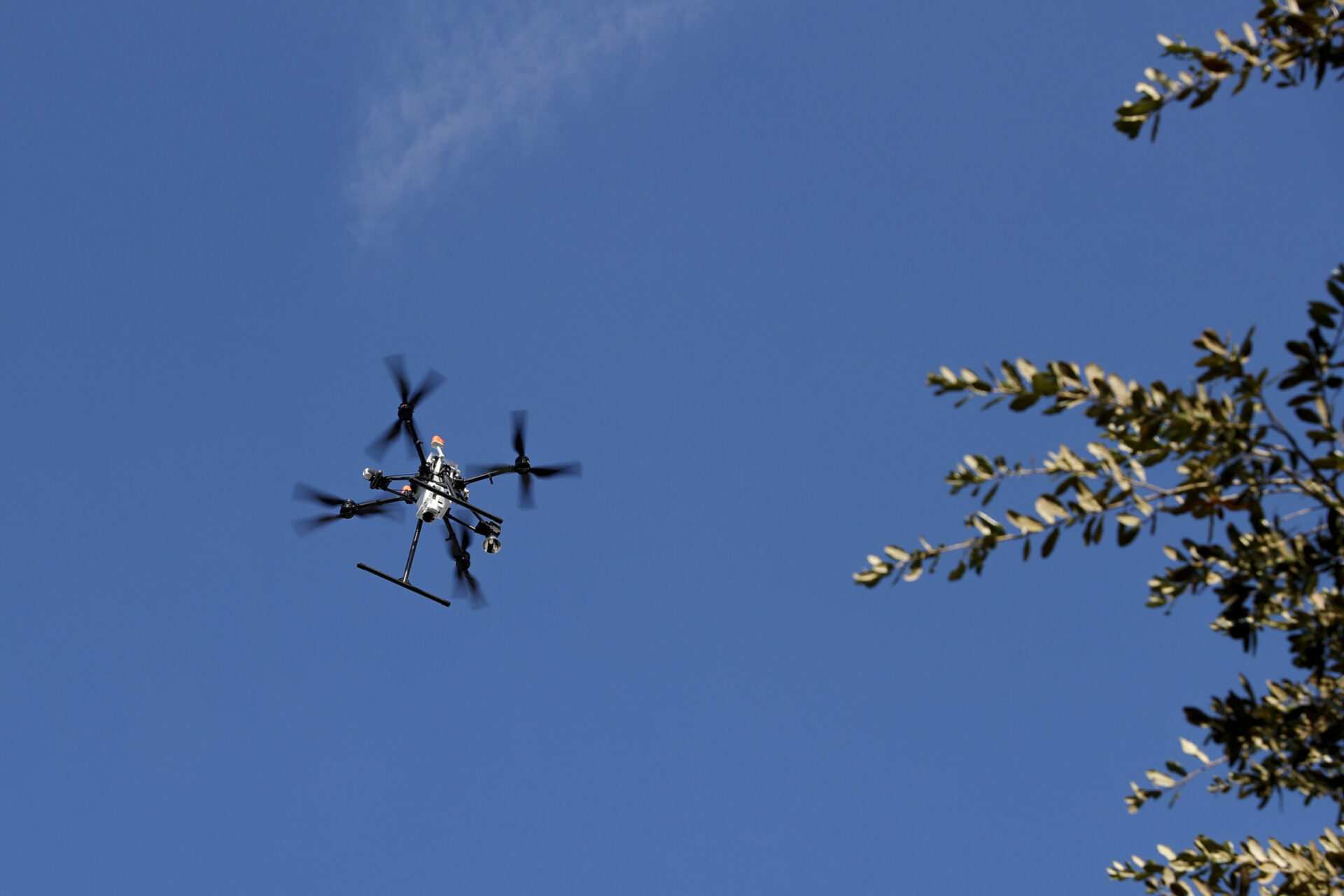This article was originally published by Radio Free Europe/Radio Liberty and is reprinted with permission.
The invasion of Israel by the Palestinian militant group Hamas has shattered the illusion of stability in the Middle East and triggered a war that could reshape great-power influence in the region and beyond.
How it all shakes out will depend in large part on the length and course of the war, including whether another Iranian-backed militant organization, Hizballah, opens a second front against Israel in the north, expanding the conflict to Lebanon and potentially Syria.
A blast that killed hundreds of people at a hospital in Gaza on October 17 ignited mutual accusations, increasing the tension hours before U.S. President Joe Biden arrived in Israel on a visit that underscored the stakes for the Middle East, Washington, and the world.
The new war may help the Kremlin by drawing attention away from the carnage it is causing in Ukraine, squeezing U.S. military resources, and bolstering Russia’s anti-Western narratives, analysts say — but a widening of the Israel-Hamas conflict could strain Moscow’s carefully cultivated Middle East ties and jeopardize its clout in the region.
Over more than two decades in power, Russian President Vladimir Putin has made significant strides in rebuilding the influence Moscow lost among predominantly Muslim countries in the Middle East following the Soviet collapse of 1991, while also establishing friendly ties with Israel.
But Israel sees Syria and Iran as serious national security threats, and Putin has strengthened Russia’s ties with both of those countries.
He has increased Russia’s military presence in Syria, where the Kremlin, Hizballah, and Iran have supported President Bashar al-Assad in his 12-year war against opposition groups — some of which are backed by the United States, which also has troops in the country. He has also expanded defense ties with Iran, a major supplier of attack drones that Russia is using in its war on Ukraine.
Now, something could break.
“The real test for Russia’s relationship with Israel is going to be what Hizballah does. If they attack, Israel is going to hit back hard at Hizballah, which is on the same team as Russia in Syria. And I think that is where we will see the relationship deteriorate,” Mark Katz, a political-science professor at George Mason University in Virginia who focuses on Russia and the Middle East, told RFE/RL.
Signs of strain are evident following Hamas’s October 7 invasion, which has killed more than 1,400 Israelis, making it the deadliest attack in the country’s history. Putin took days to comment — and when he did, in contrast to widespread Western condemnation of Hamas, he blamed the United States for failing to produce a two-state solution to the decades-old Israeli-Palestinian conflict.
In remarks during a 10-minute meeting, Putin did not mention Hamas by name, referring to “events” and “tensions” — and a draft UN Security Council resolution that Russia submitted on October 16 also made no mention of Hamas or its attack.
“Israelis are much more critical of anyone who is not siding with it, [or] at least not condemning what Hamas did,” Nimrod Goran, president of the Israeli Institute for Regional Foreign Policies in Jerusalem and a senior fellow at the Middle East Institute, told RFE/RL.
The Hamas invasion and Israel’s response brought a rash of criticism of Israel from pro-Kremlin analysts and commentators on Russian state TV. But Russia may be wary about tilting too far away from Israel and toward its foes, including Iran, analysts say.
Russia’s relations with Iran have “qualitatively changed,” Hanna Notte, a Berlin-based analyst with the James Martin Center for Nonproliferation Studies and an expert on Russian policy in the Middle East, told RFE/RL on October 9. “But still, I don’t think that Russia wants to go all-in with Iran, that it wants to disrupt its relations with Israel and with [Persian] Gulf states.”
Mark Galeotti, an author and analyst of Russian policy, said that “although there are positive relations between Russia and Iran in terms of sanctions-busting, we should remember that particularly when it comes to Middle Eastern politics, Russia and Iran are at best ‘frenemies’ — they’re rivals for supremacy.”
“We’ve seen that in Syria as well,” Galeotti said.
Syria War
Syria is Moscow’s biggest physical foothold in the Middle East. Russia’s naval and air bases there are its only military presence on the Mediterranean and thus of strategic importance, enabling it to project power outside its immediate region.
This presence depends on the survival of Assad’s government, which is also backed by Iranian and Hizballah fighters.
In 2022, Russia reportedly transferred more than 1,000 troops and an air-defense system out of Syria to support its war against of Ukraine, where Moscow’s forces suffered major setbacks in the months after Putin launched the full-scale invasion.
Should the Israeli-Hamas conflict expand and prompt Hizballah to shift fighters from Syria to Lebanon, “that would just make Russia’s job more difficult in Syria,” Katz said.
U.S.-backed and Turkish-backed fighters opposed to Assad control the country’s north. At the same time, Russia doesn’t want Iran and its proxies to gain too much influence in Syria — both because of its own relationship with Iran and because of concerns about angering Israel.
Russia, which controls a large part of the skies above Syria, has let Israeli jet fighters bomb Hizballah over the years. Israel and Russia have set up an exchange of information between their forces operating in and around Syria to reduce the risk of air incidents.
In September 2018, Israeli jets bombed a facility in Syria that Israel claimed was used to house Iranian military equipment that could be transferred to Hizballah fighters in Lebanon.
Syria fired back at the Israeli jets but hit a Russian military plane, killing all 15 people on board. Russia accused the Israeli military of using the Russian plane as a cover to dodge Syrian defense systems.
Thereafter the two countries deepened cooperation over Syrian airspace. That cooperation, analysts say, has been a key factor keeping Israel from supplying weapons to Ukraine.
“There is a need for Israel to maintain coordination with the Russians, mostly because of Syria. Even the decision taken by Israel on how to respond to the war in Ukraine was basically made on the potential impact for Israel in Syria,” Goran said.
That is unlikely to change, he added.
Nonetheless, Russia’s relations with Israel have cooled since the start of Moscow’s full-scale invasion of Ukraine in February 2022.
Putin is widely believed to have expected to bring Ukraine to its knees within days or weeks. His apparent failure to foresee a long war left Russia unprepared militarily and, with Western sanctions hampering its weapons industry, prompted it to turn to Iran and North Korea for drones and missiles.
In return, Russia has promised advanced weapons to Iran, including fighter jets. The United States has described the relationship as “unprecedented” and “a full-scale defense partnership” that poses a threat to Iran’s neighbors, including Israel.
Still, Israel has refused to join the U.S. and European Union sanctions against Russia or send weapons to Ukraine, though it did allow Washington to shift U.S. ammunition stockpiles in the country to Ukraine.
The Ukraine Aid Conundrum
While the Israel-Hamas war could stretch Russia thin and disrupt its juggling act in the Middle East, particularly if the conflict expands, Putin may hope that the benefits will outweigh the costs.
For now, the war has enabled Russia to step up the anti-Western rhetoric that has become an extremely prominent aspect of its foreign policy, as Putin woos the countries worldwide that are not allied with Washington and casts the invasion of Ukraine as a forced defense against a U.S.-led effort to weaken or destroy Russia.
While ignoring its own attacks on civilians in Ukraine, which have drawn widespread accusations of war crimes, Russia has seized on the killing of civilians in Israeli bombardments of Gaza to accuse the West of double standards, addressing audiences in the Global South and beyond and seeking to dilute anger over its actions in Ukraine.
Many analysts say Putin’s best chance of achieving anything that it can call a victory in Ukraine is for Western backing for Kyiv to fade, drying up the supply of weapons it needs to fight Russia off. There were signs of slipping support before the Hamas attack, which may have fueled hopes in the Kremlin that the United States will struggle to supply both Ukraine and Israel with arms.
The United States is running low on some munitions after delivering Ukraine more than $45 billion in military aid since February 2022. But an analysis by Mark Cancian of the Center for Strategic and International Studies, a Washington-based think tank, indicates that at least in the short term, there won’t be much of a problem.
According to Cancian, only about a dozen of the 100 military items sent by the United States to Ukraine are in short supply. Furthermore, the most important of those – High-Mobility Artillery Rocket System (HIMARS) launchers, artillery, and 155-millimeter shells — are not among Israel’s immediate needs.
“The initial ask — as currently reported — does not conflict with Ukraine’s or Taiwan’s needs,” Cancian wrote. “Nevertheless, as time goes on, there will be trade-offs as certain key systems are diverted to Israel. A few systems that Ukraine needs for its counteroffensive may not be available in the numbers that Ukraine would like.”
Biden said this week that the United States has the military resources to support Israel in its war against Hamas and Ukraine. “We can take care of both of these and still maintain our overall international defense,” Biden said in an interview aired on CBS television on October 15.
Two days later, the White House confirmed that the United States had sent Ukraine long-range ATACMS missiles, and President Volodymyr Zelenskiy said Kyiv’s forces used them in an attack on Russian airfields in the occupied Zaporizhzhya region.
Power And Personal Rapport
Meanwhile, Russia’s clout in the Middle East could be challenged by a stepped-up U.S. presence: With the deployment of two aircraft carriers, the Israel-Hamas war may reverse the recent U.S. disengagement from the region in the wake of the war in Iraq and its long aftermath.
Russia and China have been seeking to fill its shoes in the Middle East, with Beijing brokering a deal to restore diplomatic relations between Iran and Saudi Arabia.
The United States “may reaffirm its primacy” in the region, said Francois Heisbourg, a special adviser at the Fondation Pour La Recherche Strategique, a French think tank. “This could reinforce U.S. credibility in Europe.”
Bill Courtney, a foreign policy expert at the Rand Corporation in Washington, told RFE/RL that it is unclear how long-term such a shift might last, given the priority attention that the United States has given to China and the Indo-Pacific region.
Another factor playing into Russia’s prospects in the Middle East is the fate of Israeli Prime Minister Benjamin Netanyahu, whose grip on power is likely to slip as a result of the Hamas attack — a massive security failure.
Before the full-scale invasion of Ukraine, analysts say the Russian-Israeli relationship was strengthened by the personal rapport between Putin and Netanyahu, who has led Israel for most of the past 14 years and traveled to Moscow many times to meet Putin, in large part to discuss Syria and Iran.
“He is probably gone, whether soon or a few months from now,” said Kawa Hassan, a fellow with the Middle East and North Africa Program at the Stimson Center, a think tank in Washington.









